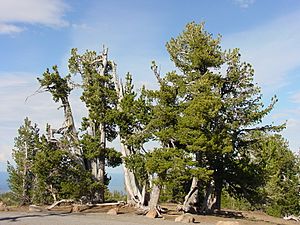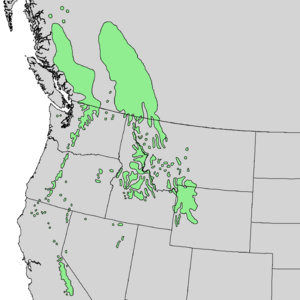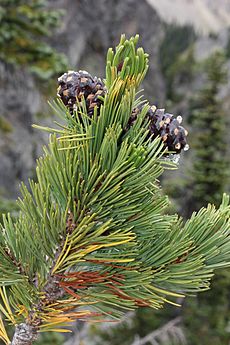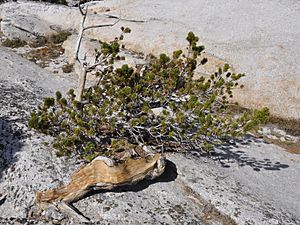Whitebark pine facts for kids
Quick facts for kids Whitebark pine |
|
|---|---|
 |
|
| A stand of whitebark pines at Crater Lake National Park in Oregon | |
| Conservation status | |
| Scientific classification | |
| Genus: |
Pinus
|
| Species: |
albicaulis
|
 |
|
| Natural range of Pinus albicaulis | |
| Synonyms | |
|
|
The whitebark pine (scientific name: Pinus albicaulis) is a type of conifer tree. It grows in the mountains of western United States and Canada. You can find it in places like the Sierra Nevada, Cascade Range, and Rocky Mountains. It often grows in high, cold areas just below the tree line.
This tree is known by many names, including white pine, pitch pine, and scrub pine. It's usually the highest-growing pine tree in these mountain ranges. Sometimes, it grows as krummholz, which means it's short and twisted. This shape helps it survive in windy, harsh conditions. In better spots, whitebark pines can grow up to 29 meters (about 95 feet) tall.
Contents
How to Identify Whitebark Pine

Whitebark pine is part of the "white pine" family. All trees in this group have their leaves (needles) in bundles of five. These bundles have a sheath that falls off. This is a key way to tell them apart from other pines. For example, lodgepole pine has two needles per bundle. Ponderosa pine and Jeffrey pine have three needles per bundle.
It can be tricky to tell whitebark pine from limber pine. Both are white pines. You usually need to look at their cones.
- Whitebark pine cones are 4 to 7 cm (1.5 to 2.7 inches) long. They are dark purple when young. They don't open when dry. Instead, their scales break easily when birds like the Clark's nutcracker try to get the seeds. You rarely find whole old cones under these trees. Its pollen cones are bright red.
- Limber pine cones are 6 to 12 cm (2.3 to 4.7 inches) long. They are green when young. They open up to release their seeds. Their scales are not fragile. You can often find whole old cones under limber pines. Their pollen cones are yellow.
Whitebark pine can also look like western white pine. But there's a trick:
- Whitebark pine needles feel smooth when you rub them gently. They are usually 4 to 7 cm (1.5 to 2.7 inches) long.
- Western white pine needles feel a bit rough because they have tiny teeth. They are usually 5 to 10 cm (2 to 4 inches) long.
Life in the Mountains: Whitebark Pine Ecology

The whitebark pine is a very important food source for many animals. Birds and small mammals eat its seeds. The most important animal is the Clark's nutcracker. This bird helps spread the pine's seeds. Nutcrackers hide about 30,000 to 100,000 seeds each year. They bury them in small, hidden spots, usually just a few centimeters under the soil.
Nutcrackers dig up these seeds when they need food or to feed their young. The spots they choose are often perfect for new trees to grow. Any seeds the nutcrackers don't eat can sprout. This is why whitebark pines often grow in clumps. Each clump comes from a single hidden stash of seeds.
Other animals also rely on whitebark pines:
- Douglas squirrels collect and store whitebark pine cones.
- Grizzly bears and American black bears often steal seeds from squirrel stashes. These seeds are an important food for bears before they hibernate.
- Squirrels, northern flickers, and mountain bluebirds often build nests in whitebark pines.
- Elk and blue grouse use whitebark pine areas as summer homes.
- Fallen needles under these trees create soft beds. Deer and wild sheep use these beds for shelter during storms.
Why Whitebark Pines are in Trouble
The whitebark pine is now listed as an endangered species. Its numbers have dropped a lot because of several problems. The main threats are a disease called white pine blister rust, outbreaks of mountain pine beetles, changes in fire ecology, and climate change. A study found that whitebark pine numbers dropped by 41% in some areas due to blister rust and pine beetles. In North Cascades National Park, whitebark pine deaths doubled in just five years.
White Pine Blister Rust
White pine blister rust is a fungal disease that came from Europe. It has infected many whitebark pine trees. In some parts of the northern Rocky Mountains, over 90% of whitebark pines have died from this disease. It also affects other valuable pines like western white pine and limber pine. Nearly 80% of whitebark pines in Mount Rainier National Park are infected.
There is no easy way to stop this rust from spreading. However, a small number of trees (less than 5%) can naturally fight off the disease. Groups like the U.S. Forest Service are working to help. They collect cones from these strong trees, grow new seedlings, and plant them in suitable places. In California, where the rust is not as bad, whitebark pine is still common in the High Sierras.
Mountain Pine Beetle Attacks
Mountain pine beetles are tiny insects that live in western North America. They have caused a lot of damage to whitebark pine forests. These beetles lay their eggs and spread harmful fungi inside the trees. This combination usually kills old or sick trees. But recently, the beetles have started attacking younger, healthy trees too.
Scientists believe global warming is a big reason for this. Since 2000, high mountain areas have become warmer. This allows the beetles to complete their life cycle faster, sometimes in just one year. This helps their populations grow very quickly. Whole areas, like near Yellowstone National Park, now have many dead whitebark trees.
In 2007, beetles had killed whitebark pines across 500,000 acres in the West. By 2009, this number grew to 800,000 acres. This was the most damage ever recorded. In the Greater Yellowstone Ecosystem alone, about 750,000 whitebark pines have died from these beetles.
Fire Suppression and Its Effects
For a long time, people tried to stop all wildfires. This is called fire suppression. But it has caused problems for whitebark pines. Whitebark pines need natural, low-level fires to stay healthy. Without these fires, other trees that like shade, like subalpine fir and Engelmann spruce, start to grow more. These other trees can take over the whitebark pine's habitat.
Also, old or sick whitebark pines that have blister rust are not destroyed by fires. This means the forest becomes less healthy over time.
Helping Whitebark Pines Survive
In 2011, the U.S. Fish and Wildlife Service said that whitebark pine needed protection. They warned that without help, the tree could disappear. In June 2012, the Canadian government officially listed whitebark pine as an endangered species. It was the first tree in western Canada to get this protection.
To help the tree, the Whitebark Pine Ecosystem Foundation was created. This group works to:
- Make people aware of the problems facing whitebark pines.
- Support projects to restore whitebark pine forests.
- Publish a newsletter called "Nutcracker Notes."
- Host workshops for people interested in protecting the tree.
This U.S. group works closely with a similar group in Canada.
Uses
Native Americans have traditionally eaten the seeds from whitebark pine cones.
Images for kids
See also
 In Spanish: Pino de corteza blanca para niños
In Spanish: Pino de corteza blanca para niños




